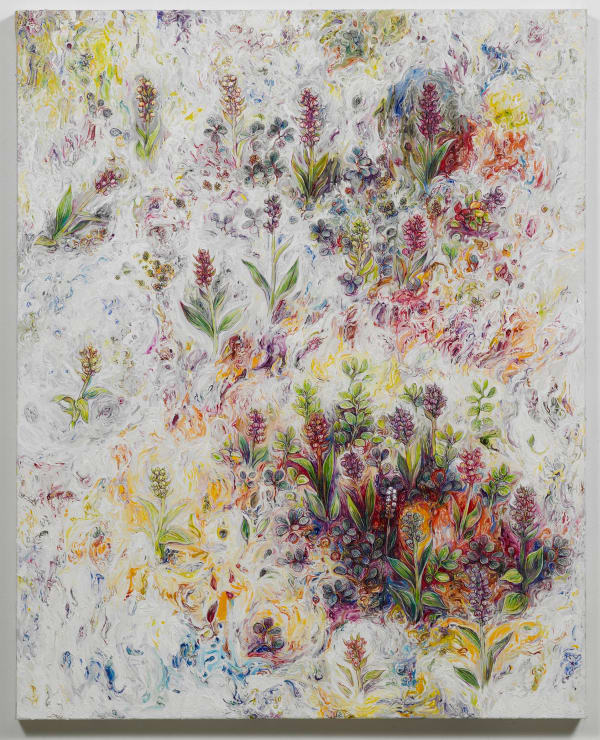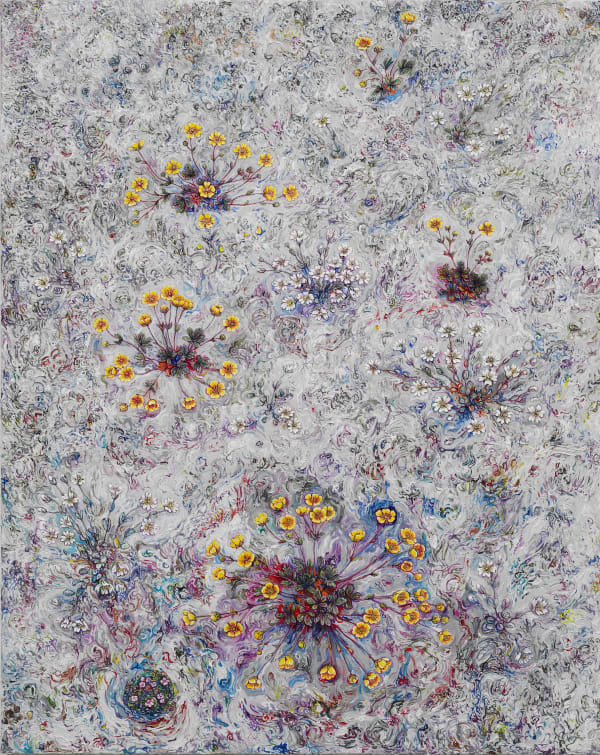EGGERT PÉTURSSON
FRAGMENTS OF A CONVERSATION WITH EGGERT PÉTURSSON
Little is left to chance with how my work is created and often my ideas are not realised until many years later. For example, I think about exhibitions in their entirety before the first brush-stroke. I had studied the new space of i8 Gallery since they moved and wanted to make something for it. The problem with beautiful exhibition spaces is that they are often so beautiful in their own right there is no need to install anything in them. In my last show at i8, there were 100 paintings scattered on the walls. That show was playful, but this time I wanted to be a bit more serious, some might say more boring – I wanted to make works all the same size, hung in a row, to address that boredom.
The size I chose for the works is 100 x 80 cm, the traditional format of portraits — this is new for me. The paintings have all the traits and qualities of a portrait, although no faces are visible in them. If there are faces to be found, it comes completely from the viewer himself. The format of a portrait is similar to a mirror. When I walk through nature I sink deep into it, and the result now hangs on the walls. In the same way, I ask those that look at the works to lose themselves in them. But it can take a long time to view the paintings – even a lifetime. The mirror format can also encourage some kind of self-reflection; the painting also watches you. In horror movies, there are portraits on the wall and real eyes behind them carefully monitor all those present. I am not too bothered about the difference between reality and fantasy; to me it is all blurred. In the end it is all fiction.
For this exhibition, the inspiration comes from all over so it is not possible to say one particular place or location is the inspiration for the works. For these paintings as others, I use my sketch- and notebooks, where all my observations can be found. The path of an idea, from first being scribbled into a notebook until it comes onto a canvas, can be fairly long. In these works, you can find the highlands, moss, a field of mud, surface, light, variations and the different colours of each type of flower. As in previous paintings, I use the background and the surroundings to illuminate the flowers; the aura and surrounding colour brings the flower to life. I apply alternating thin and thick layers; in one painting a myriad and in another a void.
My exhibition is accompanied by a print edition. A long time ago, I gave a lecture on my work where my work was projected as I went along. Something in the image processing messed up so that some of my works became negative in the projection. This gave me an idea that I finally worked out in Finland last year. I painted a small painting of common flowers: dandelions, buttercups, forget-me-nots, wild thyme, strawberries and mountain avens. Afterwards, the painting was photographed and the colours reversed. I painted the negative colours onto the original painting and the result was the painting I exhibited. Once again, a photograph was taken and the colours reversed back to the original colours. Various changes occurred in the process: the buttercup and the dandelion became blue, the wild thyme and the strawberries, green. The mountain avens, which is the national flower for both Icelanders and the Sami people, had become black. The meaning of a national flower turning black is of course open to interpretation. This is just a game of mine. Out in nature I have seen all the most vivid and the most exciting colours that are found in my work. If people do not believe me, then I encourage them to go see for themselves. We have now, for almost two centuries, learned to enjoy nature through photography. I present my work and invite people to consider nature in another way.
























